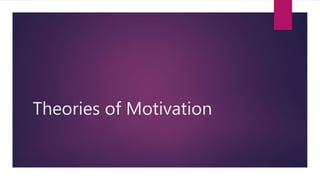
Theories of Motivation
- 2. Most Popular Theories Drive Theory Arousal Theory Expectancy Theory Goal-Setting Theory Herzberg’s Two Factor Theory
- 3. Drive Theory It is based on mainly two things Motivation and Homeostasis. According to Drive theory, biological needs arising within our bodies create unpleasant states of arousal. For e.g. – hunger, thirst, fatigue etc. In order to eliminate such feelings and restore a balanced physiological state(called homeostasis) we engage in certain activities.
- 4. Thus, according to it, motivation is basically a process in which various needs push (drive) us to actions designed to satisfy these needs. Behaviours that work are strengthened and tend to be repeated. Those that fail to produce the desired effect are weakened. Drives can also be for stimulation, status, achievement, power, and forming stable social relationships.
- 5. Biological Need Drive state Activation of many different behaviours Behaviours that reduce drive are strengthened Behaviours that do not reduce drive are weakened.
- 6. Drawback of Drive Theory Human beings often engage in actions that increase rather than reduce various drives. For e.g. – People sometimes skip snacks when hungry in order to lose weight or to maximize their enjoyment of a special dinner. Many people watch or read erotic materials in order to increase their sexual excitement, even when they don’t anticipate immediate sexual gratification.
- 7. Arousal Theory This theory is based on seeking optimum activation. It suggests that what human beings seek is not minimal levels of arousal, but rather optimal arousal – the level that is best suited to our personal characteristics and to whatever activity we are currently performing. For e.g. – During knitting, whittling etc., a low level of arousal will be optimal and preferred while during a sports event, a much higher one will be best.
- 8. Yerkes-Dodson Law There is often a close link between arousal and performance. The suggestion that the level of arousal beyond which performance begins to decline is a function of task difficulty, is known as Yerkes- Dodson Law. Large individual differences also exist with respect to preferred arousal level. For e.g.- At one extreme are people who seek and prefer higher levels of activation-people engaging in adventure sports, while on the other hand are the people who prefer much lower levels of arousal.
- 9. Drawback of Arousal Theory Arousal theory does provide useful insights into the nature of motivation. But the fact that we can’t readily predict what will constitute an optimal level of arousal does limit its usefulness to a degree.
- 10. Expectancy Theory This theory suggests that behaviour is pulled by expectations of desirable outcomes. Such outcomes are known as incentives. Incentives can be almost anything we have learned to value – money, status, approval of others etc.
- 11. Significance of Expectancy Theory Expectancy theory has found its most important application as an explanation of work motivation. Findings in the field of industrial/organizational psychology indicate that people will work hard at their jobs only when they believe that – Doing so will improve their performance (expectancy) Good performance will be recognized and rewarded (instrumentality) The rewards provided will be ones they want (valence)
- 12. Goal-Setting Theory The view that motivation can be strongly influenced by goals is central to goal- setting theory. It works best under certain conditions i.e. when the goals set are – Highly specific Challenging Attainable Finally, goal setting is most successful when people receive feed back on their progress toward meeting the goals and when they are truly and deeply committed to reaching them.
- 13. Herzberg’s Two-Factor Theory Frederick Herzberg's Two-Factor Theory, also known as Motivation-Hygiene Theory or intrinsic vs. extrinsic motivation, concludes that there are certain factors in the workplace that can cause job satisfaction and a separate set of factors that can cause dissatisfaction